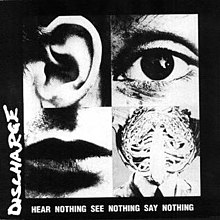Grindcore is an extreme fusion genre of heavy metal and hardcore punk that originated in the mid-1980s, drawing inspiration from abrasive-sounding musical styles, such as thrashcore, crust punk, hardcore punk, extreme metal, and industrial. Grindcore is considered a more noise-filled style of hardcore punk while using hardcore's trademark characteristics such as heavily distorted, down-tuned guitars, grinding overdriven bass, high-speed tempo, blast beats, and vocals which consist of growls, shouts and high-pitched shrieks. Early groups like Napalm Death are credited with laying the groundwork for the style. It is most prevalent today in North America and Europe, with popular contributors such as Brutal Truth and Nasum. Lyrical themes range from a primary focus on social and political concerns, to gory subject matter and black humor.
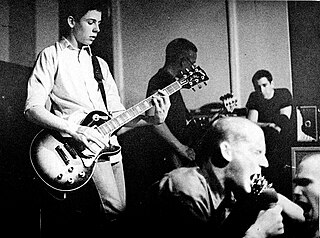
Hardcore punk is a punk rock music genre and subculture that originated in the late 1970s. It is generally faster, harder, and more aggressive than other forms of punk rock. Its roots can be traced to earlier punk scenes in San Francisco and Southern California which arose as a reaction against the still predominant hippie cultural climate of the time. It was also inspired by Washington, D.C., and New York punk rock and early proto-punk. Hardcore punk generally disavows commercialism, the established music industry and "anything similar to the characteristics of mainstream rock" and often addresses social and political topics with "confrontational, politically charged lyrics".
Digital hardcore is a fusion genre that combines hardcore punk with electronic dance music genres such as breakbeat, techno, and drum and bass while also drawing on heavy metal and noise music. It typically features fast tempos and aggressive sound samples. The style was pioneered by Alec Empire of the German band Atari Teenage Riot during the early 1990s, and often has sociological or leftist lyrical themes.
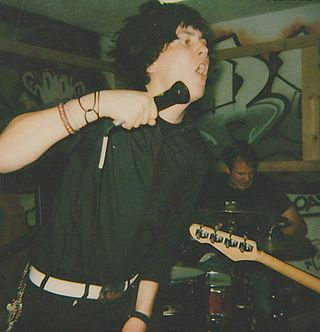
Screamo is an aggressive subgenre of emo that emerged in the early 1990s and emphasizes "willfully experimental dissonance and dynamics". San Diego-based bands Heroin and Antioch Arrow pioneered the genre in the early 1990s, and it was developed in the late 1990s mainly by bands from the East Coast of the United States such as Pg. 99, Orchid, Saetia, and I Hate Myself. Screamo is strongly influenced by hardcore punk and characterized by the use of screamed vocals. Lyrical themes usually include emotional pain, death, romance, and human rights. The term "screamo" has frequently been mistaken as referring to any music with screaming.

Crust punk is a subgenre of punk rock influenced by the English punk scene as well as extreme metal. The style, which evolved in the early 1980s in England, often has songs with dark and pessimistic lyrics that linger on political and social ills. The term "crust" was coined by Hellbastard on their 1986 Ripper Crust demo.

Refused is a Swedish hardcore punk band originating from Umeå and formed in 1991. Refused is composed of vocalist Dennis Lyxzén, guitarist Kristofer Steen, drummer David Sandström, and bassist Magnus Flagge. Guitarist Jon Brännström was a member from 1994, through reunions, until he was fired in late-2014. Their lyrics are often of a non-conformist and politically far-left nature and were for a time associated with the straight edge subculture.
Sludge metal is an extreme subgenre of heavy metal music that combines elements of doom metal and hardcore punk. The genre generally includes slow tempos, tuned down guitars and nihilistic lyrics discussing poverty, drug addiction and pollution.
Post-hardcore is a punk rock music genre that maintains the aggression and intensity of hardcore punk but emphasizes a greater degree of creative expression. Like the term "post-punk", the term "post-hardcore" has been applied to a broad constellation of groups. Initially taking inspiration from post-punk and noise rock, post-hardcore began in the 1980s with bands like Hüsker Dü and Minutemen. The genre expanded in the 1980s and 1990s with releases by bands from cities that had established hardcore scenes, such as Fugazi from Washington, D.C. as well as groups such as Big Black, Jawbox, Quicksand, and Shellac that stuck closer to post-hardcore's noise rock roots. Dischord Records became a major nexus of post-hardcore during this period.

Discharge are an English hardcore punk band formed in 1977 in Stoke-on-Trent, England. The band is known for influencing several sub-genres of extreme music and their songs have been covered by some of the biggest names in heavy metal and other genres. The musical sub-genre of D-beat is named after Discharge and the band's distinctive drumbeat.

D-beat is a style of hardcore punk, developed in the early 1980s by imitators of Discharge, after whom the genre is named, as well as a drum beat characteristic of this subgenre. D-beat is known for its "grinding, distorted and brutally political" sound. Discharge may have themselves inherited the beat from Motörhead and the Buzzcocks. D-beat is closely associated with crust punk, which is a heavier, more complex variation. The style was particularly popular in Sweden, and developed there by groups such as Crude SS, Anti Cimex, Mob 47, and Driller Killer. Other D-beat groups include Doom and the Varukers from the UK; Disclose from Japan; Crucifix and Final Conflict from the U.S.; Ratos de Porão from Brazil; and MG15 from Spain. While the style initially developed in the early 1980s, a number of new groups working within the subgenre emerged in the mid-1990s. These include the Swedish groups Wolfbrigade, Totalitär, Avskum, Skitsystem, and Disfear.
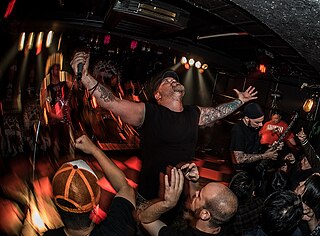
Integrity is a hardcore punk band originally from Cleveland, Ohio, but based in Belgium since 2003. It was formed in 1988 by lead vocalist Dwid Hellion.

Boris is a Japanese band formed in 1992 in Tokyo and composed of drummer Atsuo, guitarist/bassist Takeshi, and guitarist/keyboardist Wata. All three members contribute vocals. Their work has drawn variously on styles such as sludge metal, drone, noise, psychedelia, and minimalism. Boris has released more than 20 studio albums on various labels around the world, as well as a variety of live albums, compilations, EPs, singles, and collaborative albums. They have collaborated with acts such as Sunn O))), Merzbow, Keiji Haino, and guitarist Michio Kurihara.
HellsBelles is a heavy metal band from England active from 1984 to 1987 and 1998 to present, considered part of the latter stages of the new wave of British heavy metal (NWOBHM).
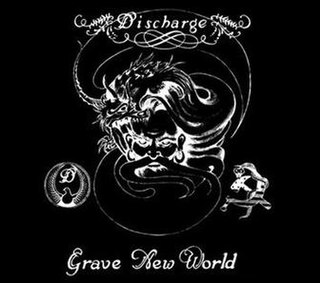
Grave New World is the second studio album by English hardcore punk band Discharge, released in 1986 by Clay Records. The album marks a radical stylistic change, with the band abandoning their previous hardcore punk style for a softer, and more accessible glam metal sound. The band split up in 1986, shortly after the album's release, but would end up reforming in 1990.
Punk jazz is a genre of music that combines elements of jazz, especially improvisation, with the instrumentation and performance style of punk rock. The term was first used to describe James Chance and the Contortions' 1979 album Buy. Punk jazz is closely related to free jazz, no wave, and loft jazz, and has since significantly inspired post-hardcore and alternative hip hop.

The Copyrights are a pop punk band from Carbondale, Illinois, made up of Adam Fletcher, Brett Hunter, Kevin Rotter, and Luke McNeill (drums). They are currently signed to Fat Wreck Chords. They are known for what Alternative Press calls "both the sloppy, slacker pop-punk of, say, early Green Day with the slightly more polished sheen of Teenage Bottlerocket or recent Bouncing Souls".
The emo revival, or fourth wave emo, was an underground emo movement which began in the late 2000s and flourished until the mid-to-late 2010s. The movement began towards the end of the 2000s third-wave emo, with Pennsylvania-based groups such as Tigers Jaw, Algernon Cadwallader and Snowing eschewing that era's mainstream sensibilities in favor of influence from 1990s Midwest emo. Acts like Touché Amoré, La Dispute and Defeater drew from 1990s emo and especially its heavier counterparts, such as screamo and post-hardcore.
Beatdown hardcore is a subgenre of hardcore punk with prominent elements of heavy metal. Beatdown hardcore features aggressive vocals, gang vocals, heavy guitar riffs and breakdowns and lyrics discussing unity, brotherhood, volatile interpersonal relationships and machismo. The genre has its origins in late 1980s New York hardcore bands such as Breakdown, Killing Time and Madball, and was pioneered in the mid-1990s by bands like Bulldoze, Terror Zone and Neglect. The definition of the genre has expanded over time to incorporate artists increasingly indebted to metal, notably Xibalba, Sunami and Knocked Loose.
